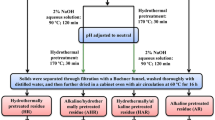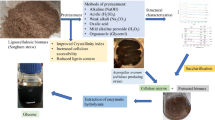Abstract
Purpose
The aerial part of the cassava plant comprising stems, leaves and cassava peels are waste biomasses generated during the cultivation and processing of cassava. The potential of these biomasses as alternative substrates for the production of bioethanol was investigated.
Methods
The efficacy of three types of pretreatments such as (i) hydrothermal treatment, (ii) microwave exposure of acid slurry and (iii) dilute acid treatment (steam as well as under pressure) in enhancing the enzymatic degradability of agricultural residues of cassava was investigated.
Results
Whilst cassava stems and peels had 15.00 and 29.84 % starch along with 22.8 and 14 % cellulose respectively, dry leaves had only 2.43 % starch and 17.3 % cellulose. Hemicellulose ranged from 23 to 29 % in these biomasses. The pretreated biomasses were compared with the native samples for the fermentable sugar yield during enzyme saccharification by the cellulolytic enzyme complex, Accellerase™ 1000. Among the pretreatments, hydrothermal treatment (HT) of moist powders for 30 min was the most effective in giving the highest yield of reducing sugars, followed by microwave assisted dilute acid treatment for 20 min. Extending the exposure time for HT to 45 and 60 min reduced the sugar yield. Leaf was the most recalcitrant among the three biomasses. Ultrastructural studies using Scanning electron microscopy also supported the saccharification data. Very high extent of release of sugars during saccharification was noticed from cassava peels which also had Ca. 29.84 % starch. Optimal level of Accellerase required for saccharification was 500 mg enzyme protein.
Conclusions
It was concluded from the study that hydrothermal treatment of the powdered biomasses for 30 min was the most appropriate technique to enhance the biodegradation by cellulolytic enzymes.




Similar content being viewed by others
References
Sun, Y., Cheng, J.: Hydrolysis of lignocellulosic materials for ethanol production: a review. Bioresour. Technol. 83, 1–11 (2002)
Cara, C., Moya, M., Ballesteros, I., Negro, M.J., Gonzalez, A., Ruiz, E.: Influence of solid loading on enzymatic hydrolysis of steam exploded or liquid hot water pretreated olive tree biomass. Process Biochem. 42, 1003–1009 (2007)
Petersen, M.O., Larsen, J., Thomsen, B.H.: Optimization of hydrothermal pretreatment of wheat straw for production of bioethanol at low water consumption, without addition of chemicals. Biomass Bioenergy 33, 834–840 (2009)
Hendriks, A.T.W.M., Zeeman, G.: Pretreatments to enhance the digestibility of lignocellulosic biomass. Bioresour. Technol. 100, 10–18 (2009)
Lynd, L., Elander, R., Wyman, C.: Likely features and costs of mature biomass to ethanol technology. Appl. Biochem. Biotechnol. 57–58, 741–761 (1996)
Mosier, N., Wyman, C., Dale, B., Elander, R., Lee, Y.Y., Holtzapple, M.T., Ladisch, M.: Features of promising technologies for pretreatment of lignocellulosic biomass. Bioresour. Technol. 96, 673–686 (2005)
Yang, B., Wyman, C.E.: Pretreatment: The key to unlocking low cost cellulosic ethanol. Biofuels Bioprod. Biorefining 2, 26–40 (2008)
Zhang, B., Shahbazi, A.: Recent developments in pretreatment technologies for production of lignocellulosic biofuels. Pet. Environ. Biotechnol. 2, 2–8 (2011)
Brodeur, G., Yau, E., Badol, K., Collier, J., Ramachandran, K.B., Ramakrishnan, S.: Chemical and physiochemical pretreatment of lignocellulosic biomass: A review. Enzyme Res. (2011). doi:10.4061/2011/787532
Fengel, D., Wegener, G.: Wood: Chemistry, Ultrastructure Reactions. W de Gruyter, Berlin (1984)
Chang, V.S., Holtzapple, M.T.: Fundamental factors affecting biomass enzymatic reactivity. Appl. Biochem. Biotechnol. 84, 5–37 (2000)
Wyman, C.E.: Biomass ethanol: Technical progress, opportunities and commercial challenges. Annl. Rev. Energy Environ. 24, 189–226 (1996)
FAOSTAT FAO Production Statistics. (2012) faostat.fao.org/site/339/default.aspx. Accessed 15 Jan 2014
Johnson, P.N., Raymond, W.D.: The chemical composition of some tropical food plants IV. Manioc. Trop. Sci. 7, 109–112 (1965)
Divya Nair, M.P., Padmaja, G., Moorthy, S.N.: Biodegradation of cassava starch factory residue using a combination of cellulases, xylanases and hemicellulases. Biomass Bioenergy 35, 1211–1218 (2011)
Divya Nair, M.P., Padmaja, G., Sajeev, M.S., Sheriff, J.T.: Bioconversion of cellulo-starch waste from cassava starch industries for ethanol production using pretreatment techniques and improved enzyme systems. Ind. Biotechnol. 8, 300–308 (2012)
Anon. Spezyme_ Xtra-High performance a-amylase for starch hydrolysis. Spezyme Xtra Product Information published by Genencor International, a Division of Danisco (2011a)
Anon. Stargen 001-granular starch hydrolyzing enzyme for ethanol production. Stargen product brochure published by Genencor International, a Division of Danisco. Available from: http://www.beutilityfree.com/pdffiles/Stargen-001.pdf (2011b)
Shanavas, S., Padmaja, G., Moorthy, S.N., Sajeev, M.S., Sheriff, J.T.: Process optimization for bioethanol production from cassava starch using novel eco-friendly enzymes. Biomass Bioenergy 35, 901–909 (2011)
Nelson, N.: A photometric adaptation of the Somogyi method for determination of glucose. J. Biol. Chem. 153, 375–380 (1944)
Moorthy, S.N., Padmaja, G.: A rapid titrimetric method for the determination of starch content in cassava tubers. J. Root Crops 28, 30–37 (2002)
Sadasivam, S., Manickam, A.: Biochemical Methods. New Age International Publishers, New Delhi (1996)
Goering, H.D., Vansoest, P.J.: Forage fiber analysis. USDA Agricultural Research Service, Washington (1975)
AOAC Official Methods of Analysis of AOAC International, 18th Edition William Horwitz and George W Latimer (eds.). (2005)
Kumar, P., Barrett, D.M., Delwiche, M.J., Stroeve, P.: Methods of pretreatment of lignocellulosic biomass for efficient hydrolysis and biofuel production. Ind. Eng. Chem. Res. 48, 3713–3729 (2009)
Klingspohn, U., Bader, J., Kruse, B., Kishore, P.V., Schiiger, K., Kracke-Helm, H.A., Likidis, Z.: Utilization of potato pulp from potato starch processing. Process Biochem. 28, 91–98 (1993)
Mayer, F.: Potato pulp: Properties, physical modification and applications. Polym. Degrad. Stab. 59, 231–235 (1998)
Nomanbhay, S.M., Hussain, R., Palanisamy, K.: Microwave assisted enzymatic saccharification of oil palm empty fruit bunch fiber for enhanced fermentable sugar yield. J. Sustain. Bioenergy Syst. 3, 7–17 (2013)
Thompson, D.N., Chen, H.C., Grethlein, H.E.: Comparison of pretreatment methods on the basis of available surface area. Bioresour. Technol. 39, 155–163 (1992)
Gregg, D., Saddler, J.N.: A techno-economic assessment of the pretreatment and fractionation steps of a biomass-to-ethanol process. Appl. Biochem. Biotechnol. 57–58, 711–727 (1996)
Grethlein, H.E.: The effect of pore size distribution on the rate of enzymatic hydrolysis of cellulose substrates. Bioresour. Technol. 3, 155–160 (1985)
Palonen, H., Thomsen, A.B., Tenkanen, M., Schmidit, A.S., Viikari, L.: Evaluation of wet oxidation pretreatment for enzymatic hydrolysis of softwood. Appl. Biochem. Biotechnol. 117, 1–17 (2004)
Laser, M., Schulman, D., Allen, S.G., Lichwa, J., Antal, M.J., et al.: A comparison of liquid hot water and steam pretreatments of sugarcane bagasse for bioconversion to ethanol. Bioresour. Technol. 81, 33–44 (2002)
Zhang, B., Shahbazi, A., Wang, L., Diallo, O., Whitmore, A.: Hot water pretreatment of cattails extraction of cellulose. J. Ind. Microbiol. Biotechnol. 38, 819–824 (2010)
Antal Jr, M.J.: Water: A traditional solvent pregnant with new applications. In: White Jr, H.J. (ed.) Proceedings 12th International Conference on the Properties of Water and Steam, pp. 24–30. Begell House, New York (1996)
Duff, S.J.B., Murray, W.D.: Bioconversion of forest products industry waste cellulosics to fuel ethanol: a review. Bioresour. Technol. 55, 1–33 (1996)
Kandari, V., Gupta, S.: Bioconversion of vegetable and fruit peel wastes in viable product. J. Microbiol. Biotech. Res. 2, 308–312 (2012)
Grous, W.R., Converse, A.O., Grethlein, H.E.: Effect of steam explosion pretreatment on pore size and enzymatic hydrolysis of poplar. Enzyme Microbiol. Technol. 8, 274–280 (1986)
Ooshima, H., Aso, K., Harono, Y., Yamamoto, T.: Microwave treatment of cellulosic materials for their enzymatic hydrolysis. Biotechnol. Lett. 6, 289–294 (1984)
Palav, T., Seetharaman, K.: Impact of microwave heating on the physiochemical properties of a starch water model system. Carbohydr. Polym. 67, 596–604 (2007)
Xiong, J., Ye, J., Liang, W.Z., Fan, P.M.: Influence of microwave on the ultrastructure of cellulose. J. South China Univ. Technol. 28, 84–89 (2000)
Zhu, S., Wu, Y., Yu, Z., Chen, Q., Wu, G., Yu, F., Wang, C., Jin, S.: Microwave-assisted alkali pretreatment of wheat straw and its enzymatic hydrolysis. Process Biochem. 94, 437–442 (2006)
Binod, P., Satyanagalakshimi, K., Sindhu, R., Janu, U., Sukumaran, R.K., Pandey, A.: Short duration microwave assisted pretreatment enhances the enzymatic saccharification and fermentable sugar yield from sugarcane bagasse. Renew. Ener. 37, 109–116 (2012)
Digman, M.F., Shinners, K.J., Casler, M.D., et al.: Optimizing on-farm pretreatment of perennial grasses for fuel ethanol production. Bioresour. Technol. 101, 5305–5314 (2010)
Du, B., Sharma, L.N., Becker, C., et al.: Effect of varying feedstock-pretreatment chemistry combination on the formation and accumulation of potentially inhibitory degradation products in biomass hydrolysates. Biotechnol. Bioeng. 107, 430–440 (2010)
Kumar, R., Wyman, C.E.: Access of cellulase to cellulose and lignin for poplar solids produced by leading pretreatment technologies. Biotechnol. Prog. 2, 807–819 (2009)
McMillan, J.D.: Pretreatment of lignocellulosic biomass. In: Himmel, M.E., Baker, J.O., Overend, R.P. (eds.) Enzymatic Conversion of Biomass for Fuels Production, pp. 292–324. American Chemical Society, Washington DC (1994)
Chantawongsa, N., Kongkiattikajorn, J.: Pretreatment methods for banana peel as a substrate for the bioproduction of ethanol in SHF and SSF. Internat. J. Comput. Internet Manage. 21, 15–19 (2013)
Acknowledgments
The first author acknowledges with gratitude the research fellowship granted for the study by the Kerala State Council for Science, Technology and Environment (KSCSTE), Govt. of Kerala. Authors are thankful to the Director for the facilities provided for the study and Dr. J. Sreekumar, Senior Scientist, CTCRI for the help extended in statistical analyses. We also acknowledge the help extended by the Sophisticated Testing and Instrumentation Centre, Cochin University of Science and Technology, Kerala for the Scanning Electron Microscopic studies.
Author information
Authors and Affiliations
Corresponding author
Rights and permissions
About this article
Cite this article
Pooja, N.S., Padmaja, G. Enhancing the Enzymatic Saccharification of Agricultural and Processing Residues of Cassava through Pretreatment Techniques. Waste Biomass Valor 6, 303–315 (2015). https://doi.org/10.1007/s12649-015-9345-8
Received:
Accepted:
Published:
Issue Date:
DOI: https://doi.org/10.1007/s12649-015-9345-8




